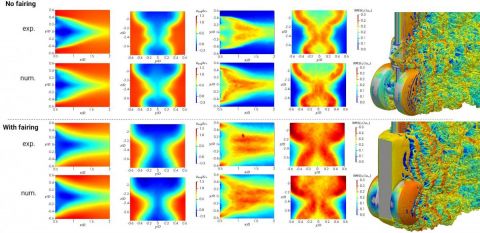Assessment of flow-through fairings based on innovative numerical simulations
One leading objective of the project INVENTOR is the improvement of high-fidelity numerical methods for the prediction of the turbulent flow and acoustic field around airframe components such as a landing gear (LG) to finally rate different noise reduction technologies (NRT).
Therefore, a simplified two-wheel nose landin gear (derived from the LAGOON design) is investigated by CHALMERS, ONERA, TU Delft, and RWTH with different numerical methods.
Here, the flow field is accessed through large eddy simulation (LES) using conventional Navier-Stokes finite-volume, hybrid zonal RANS/LES (ZDES) solvers, or codes based on the lattice Boltzmann equation. The acoustic far-field prediction is based on integral methods such as the Ffowcs Williams and Hawkings method or CAA methods solving for perturbation equations.
Different concepts of porous fairings are installed upstream of the LG, e.g., wiremeshes, perforated plates and metallic wool. Due to the discrepancy in length scales between the turbulent flow around the landing gear (~O(10 cm)) and inside of the porous micro-structures (~O(0.1 mm)), the full resolution of the flow through the fairing is beyond today's computing power for realistic applications. Therefore, the effect of porous solid matrix is accounted by different modeling approaches.
These are calibrated by experimental data obtained in WAABLIEF and B2A.
The numerical results will be cross-compared in detail with each other as well as with experimental data measured at A-Tunnel (TU Delft). The figure below gives an example of two flow fields around the LAGOON landing gear measured by PIV and computed via CFD (by RWTH) without (top) and with (bottom) a porous fairing.
Example of two flow fields around the LAGOON landing gear measured by PIV and computed via CFD without (top) and with (bottom) a porous fairing (courtesy of RWTH, University of Aachen).

